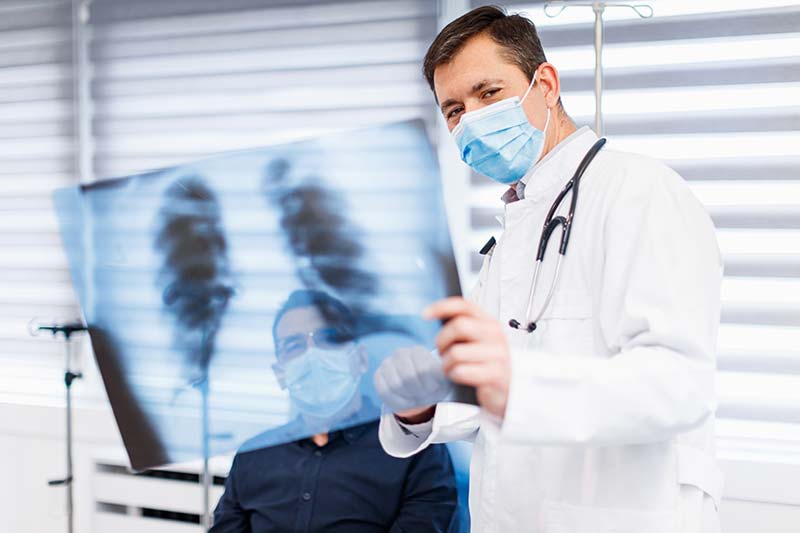Occupational pneumoconiosis is a type of interstitial lung disease (ILD) caused by repeatedly breathing in mineral dust particles over an extended period.
It’s considered occupational because people typically encounter these forms of dust in their workplace. The disease takes years to develop, as the body can’t eliminate these particles. Over time, they build up, causing inflammation and scar tissue.
Black lung disease, which coal miners experience, is a form of occupational pneumoconiosis.
Because the disease has no cure, prevention is our best defense against it, so knowing the steps you can take to protect yourself when around this dust is important.
 Also, working with a team of interstitial lung disease specialists, like the ones at The Ohio State University Wexner Medical Center, can help you with prevention and managing symptoms that do arise.
Also, working with a team of interstitial lung disease specialists, like the ones at The Ohio State University Wexner Medical Center, can help you with prevention and managing symptoms that do arise.
Our interstitial lung disease program within Ohio State’s Lung Center specializes in treating people with pulmonary diseases like occupational pneumoconiosis, so we provide the expert and personalized care you need.
Cause of occupational pneumoconiosis
Pneumoconiosis is your lung’s reaction to inhaling certain kinds of dust, typically those found in certain workspaces, such as in coal mines or on construction sites.
Breathing in these particles repeatedly over time — you won’t get pneumoconiosis after just one exposure — damages the lungs. The type of occupational pneumoconiosis you have will depend on the type of dust that you’ve been breathing.
Some types of pneumoconiosis include:
- Black lung disease – This is the condition that affects coal miners.
- Brown lung – Those who work regularly with cotton and other types of fibers can develop this.
- Silicosis – Silicon dust, which can be found on construction sites and in foundries, can lead to this form of pneumoconiosis.
- Asbestosis – Those with repeated contact with asbestos often have lung issues.
- Siderosis – Welders can develop this after years of inhaling iron dust particles.
- Hard metal pneumoconiosis – This happens due to cobalt or tungsten carbide exposure.
- Popcorn lung – Regular inhalation of diacetyl, the compound that gives some movie-theater popcorn its buttery flavor, can cause this disease. Some popcorn manufacturers have stopped using it to protect their employees; however, diacetyl can still be found in certain vaping products.
Occupational pneumoconiosis symptoms
Damage from pneumoconiosis causes you to lose blood vessels and air sacs in your lungs. Tissues surrounding the air sacs and airways become thick and stiff, making it difficult to breathe. Scarring makes it more difficult to breathe and leads to other respiratory symptoms that can greatly impact your life.
In more complex cases, symptoms are very apparent; however, in simpler cases, symptoms may not be present at all, and the disease shows up only on a chest X-ray.
Other symptoms of the condition include:
- Cough
- Shortness of breath
- Phlegm
- Fatigue or exhaustion
These symptoms mimic those of other respiratory illnesses, but your known exposure to certain types of dust can help us make a proper diagnosis.
Diagnosing pneumoconiosis
If you have a history of working around coal, cotton fibers or asbestos and you begin to develop some of these respiratory symptoms, we’ll likely do a chest X-ray first to see if any of the disease markers are present.
The Federal Mine Safety and Health Act requires all coal miners to be offered an X-ray following three years of employment and every five years after that to look for the disease.
Other tools we might use to make a diagnosis include:
- Work and medical history
- Physical examination
- Blood tests
- Lung function tests, like spirometry and oximetry
- Advanced imaging, such as CT scans
- Lung biopsy
Occupational pneumoconiosis treatment
There’s no cure for pneumoconiosis, nor can we reverse lung damage or scarring that’s already occurred.
Our treatment for this disease focuses on managing symptoms and improving quality of life.
If you’re diagnosed with this condition, you’ll need to stop all exposure to the dust suspected of causing your symptoms. You’ll also need to stop smoking if you do smoke.
Treatments we offer include:
- Oxygen therapy
- Pulmonary rehabilitation to learn more efficient ways of breathing
- Medications, including bronchodilators to open airway and antifibrotic therapy
- Lung transplant for severe cases
Also, receiving the pneumonia vaccine and an annual flu vaccine is important to living with occupational pneumoconiosis.
Preventing pneumoconiosis
Since there’s no cure for the condition and people still need to do these jobs where they’re exposed to harmful dust particles, taking steps to prevent the disease is extremely important.
Ways to prevent occupational pneumoconiosis include:
- Wearing a mask when working with these chemicals
- Washing hands and other body parts that have come in contact with dust, especially before eating or drinking
- Safely removing and cleaning any clothing used while working
- Seeing a doctor regularly and discussing any new respiratory symptoms
- Getting regular chest X-rays
- Not smoking

